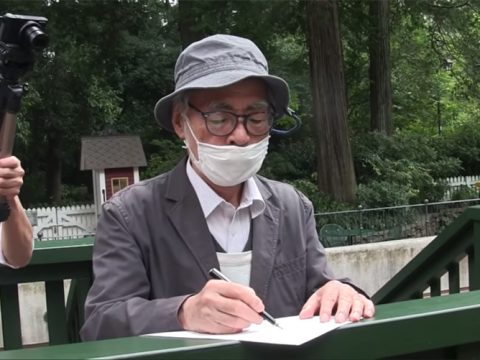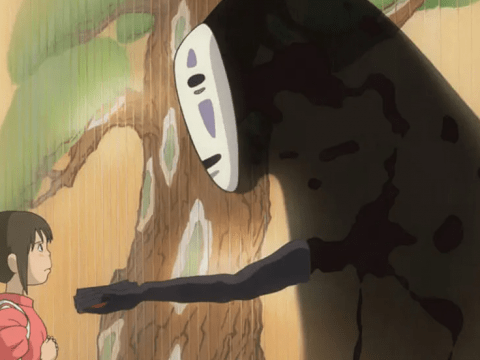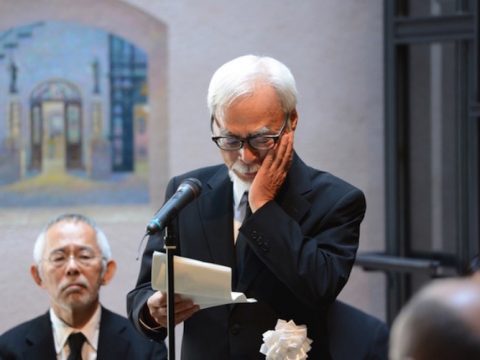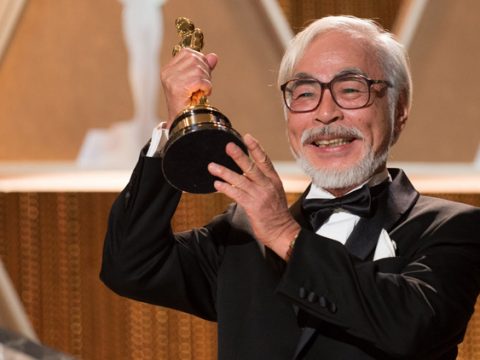Continued from Part 1.
Next they discussed a bit the tendency in Japan for the auteur theory to be pretty heavily used, at least in terms of the storyboarding process: “In Japan, it’s a normal method to have the director draw the storyboard. So occasionally there are different people working on it, somebody who draws the storyboard and somebody who directs the films, but that’s not the usual method. In fact it’s almost a condition to become a director, to be able to draw the storyboard. So if a person can’t draw a storyboard he’ll be thought of as unnecessary to the production of the film, even though he is the director. [unclear] That’s one way of thinking…”
Miyazaki’s creative process involves seeing the light at the end of the tunnel:
“…it’s only when I’ve tried something and I realize that I can’t go on this path anymore, I can’t push this idea anymore, and I abandon it and then find something else that I think I have the core to make the movie. And this is what I tell my staff – it might be a kind of a loser’s way of thinking about it, but I tell them that they have to really struggle hard and do something that seems like it’s just useless and impossible, and then they’ll find something.”
Like most artists, he seems to have a tiny horror of his own work, “…after a film is made I don’t want to see it again and I try to forget about it as soon as possible,” but at the same time he cannot complain too much at home or his wife stops listening to him, “I told my wife when I was making my second film, Nausicaä of the Valley of the Wind, that I don’t want to go through this kind of pain again.”
After Miyazaki explained the trials of being a hold-out in the world of hand-drawn animation (aka “rowing a barque among many high speed boats in the sea”), when lots of other companies are outsourcing to Korea or China, using CG, Kelts asked him to explain the virtues of Studio Ghibli’s style. Besides the realization that they were able to draw it “…faster and easier by hand than by computer…” he explained:
“…I think it’s a matter of thinking that we should be more casual about drawing animation. I think we’re freer when we are able to draw by hand. When the character is feeling very downtrodden, we can draw the character very thin and small, and when the character is full of confidence, we can draw his head bigger and show the feeling that he has. It’s difficult to get this kind of feeling into the computer…”
Kelts’ next question was another that seemed a little goofy, whether or not hand-drawn animation is “particular or peculiarly Japanese” – obviously not true, since for most of history hand-drawn was the only-drawn. Miyazaki did say that, “We make our animation for the Japanese audience and it’s the Japanese audience that supports us — when we take our films to other countries its sort of like a bonus for us. So I’d like to continue to be able to eat our rice in Japan.”
As far as the spirit of the work done between Japan and Korea/China, Miyazaki said, “I think perhaps within the European Union you could have that kind of cross country collaboration/workflow, but in East Asia it’s not unified like that so I think it’s difficult.
Kelts also tried to get him to comment on the Japanese government’s “soft power” initiative (influencing other countries via anime, manga, fashion), but all Miyazaki had to say on that topic was, “I think that government will soon change.”
The audience questions were pretty good. The first was the question you would expect – advice for aspiring animators:
“I think you must sketch what you see with your own eyes and have somebody who will critique your sketches in a strict way and not try to coddle you.”
One person asked which of his characters reminds him most of himself, an answer to which he took the physical tack, “I try not to show myself in the films. There might be a weakness of mine that if you’re not a very good drawer then your face comes out in all kinds of drawings you do.”
The “creative block” question was an interesting one, because it was hard to tell if his answer had some idiomatic cultural points that were lost in translation:
“The only thing I can do is think. When I’m really thinking hard, then I smell blood deep in my nose. So when I’m really thinking hard, it’s not necessarily that thought process, but something might just come to me out of the blue, seemingly, but I have to have really hit a wall and be really thinking hard and be really troubled by this to have that come.”
“This is my own theory, but I think we do a lot of our thinking with the surface of our brain, and then there’s the subconscious, and then there’s an even deeper place, a deeper darker place. What we really want to say can only be said when we go to our subconscious, and if we really get stuck there then we have to go deeper, and that deep place is the most difficult to get to and that’s when I smell the most blood.”
“Smelling blood,” as it turns out is an idiom for seeing the advantage of a situation, which I think fits this setting. Unfortunately I’m not sure if what he said was actually this idiom or the literal translation she gave, but it’s something to think about, anyways!
Another audience member asked whether he thinks children 50 years from now will still relate to his films. His answer expressed a more restrained goal, “I think it would be wonderful if I could make a film so that the grandma can tell the grandchild that this is a wonderful movie, you should see it. Maybe we could do that, but I’m not sure I can make a film that a mother could tell her child that she wants to see it.”
When discussing his goals in filmmaking, Miyazaki seemed nostalgic for the days when he first started out:
“Rather than saying they’re my films I prefer to say they’re ‘our films’ that we make. And it’s not necessarily that I’m thinking of my current staff when I say ‘our films.’ I’m thinking of the people that I started working with in my 20s and when we discussed among each other that we want to quit making these trashy things and we want to make better films – those are the people I’m thinking of. Many of them are no longer working in the animation area or they’ve retired or whatever, but it’s those people, my old colleagues, that I think about when I’m thinking ‘our films.'”
An audience member asked for a definition of true love and it sounds like Miyazaki does believe in it:
“I think it’s at the end of all our problems that we find it. We find true love. When we finished making the movie Ponyo, the staff said, ‘Sosuke is going to have a lot of difficulty being with Ponyo from now on.’ I said, ‘He’ll be all right.’ I was the only one who was saying that. That’s what life is, to deal with difficulties.”
However, he pretty much refused to answer the question about his hope for the future of animated filmmaking:
“Those who want to make films should be making films. I don’t like to discuss or theorize about the future. I think what we need to focus on is what we can do now, so I don’t want to think about the future in that way.”
When asked about his influences or peers, he named Nick Park from Aardman and John Lasseter from Pixar as his “comrades in arms.” He did not admit to being influenced by European landscapes in his setting designs, instead saying, “It’s animation, so when I set it in Japan I can use Japanese settings and change them from reality to make it fit my film.”
Setting is also part of the reason he would not consider making a live-action film:
“You’d have to turn the Japanese landscape back about 50 years, and that’s a little difficult to do to make a live-action film. The road, the railways, the factories, the inlets, the clouds – everything’s different, so we’d have to use a lot of computer technology to change it and that seems too difficult to do. Even people’s faces are different now.”
He doesn’t have a favorite film of his, since he thinks of them as his children:
“I don’t think if you have many children that you can say this one I love better than the other one. They’re all precious to the parent, so for me all my films are precious.”
Finally, of course, the question became what he will be up to next:
“I don’t really know, myself. People say that I am very active and energetic for my age, but I often feel tired; I feel like what I might make in the future can’t be decided just by my own will. It becomes whether I choose to keep drawing and perhaps flop down dead in the midst of drawing, but that’s not a very cool way to go.”
With all due respect, I would answer, “On the contrary!” It’s painful to imagine a Studio Ghibli without Hayao Miyazaki, but he seems prepared for the inevitability. Perhaps his future work will highlight the next up-and-comer to watch.
All images © Studio Ghibli / Disney







